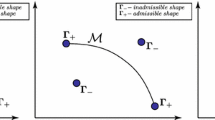Abstract
3D shape modeling is a crucial component of rapid prototyping systems that customize shapes of implants and prosthetic devices to a patient’s anatomy. In this paper, we present a solution to the problem of customized 3D shape modeling using a statistical shape analysis framework. We design a novel method to learn the relationship between two classes of shapes, which are related by certain operations or transformation. The two associated shape classes are represented in a lower dimensional manifold, and the reduced set of parameters obtained in this subspace is utilized in an estimation, which is exemplified by a multivariate regression in this paper. We demonstrate our method with a felicitous application to estimation of customized hearing aid devices.
Chapter PDF
Similar content being viewed by others
Keywords
These keywords were added by machine and not by the authors. This process is experimental and the keywords may be updated as the learning algorithm improves.
References
Hertzmann, A., Jacobs, C., Oliver, N., Curless, B., Salesin, D.: Image analogies. In: SIGGRAPH Conference Proceedings (2001)
Cootes, T., Taylor, C., Cooper, D., Graham, J.: Active shape models - their training and application. Computer Vision and Image Understanding 61(1), 38–59 (1995)
Paulsen, R., Larsen, R., Nielsen, C., Laugesen, S., Ersboll, B.: Building and testing a statistical shape model of the human ear canal. In: Dohi, T., Kikinis, R. (eds.) MICCAI 2002. LNCS, vol. 2489, pp. 373–380. Springer, Heidelberg (2002)
Paulsen, R.R., Hilger, K.B.: Shape modelling using markov random field restoration of point correspondences. In: Taylor, C.J., Noble, J.A. (eds.) IPMI 2003. LNCS, vol. 2732, pp. 1–12. Springer, Heidelberg (2003)
Darkner, S., Larsen, R., Paulsen, R.: Analysis of deformation of the human ear and canal caused by mandibular movement. In: Ayache, N., Ourselin, S., Maeder, A. (eds.) MICCAI 2007, Part II. LNCS, vol. 4792, pp. 801–808. Springer, Heidelberg (2007)
Leventon, M., Grimson, W., Faugeras, O.: Statistical shape influence in geodesic active contours. In: IEEE CVPR, Hilton Head, vol. 1 (2000)
Rathi, Y., Dambreville, S., Tannenbaum, A.: Statistical shape analysis using kernel pca. In: IS&T, SPIE Symposium on Electronic Imaging (2006)
Aguirre, M., Linguraru, M., Marias, K., Ayache, N., Nolte, L.P., Ballester, M.: Statistical shape analysis via principal factor analysis. In: IEEE Int. Symp. Biomedical Imaging (2007)
Rao, A., Aljabar, P., Rueckert, D.: Hierarchical statistical shape analysis and prediction of sub-cortical brain structures. Medical Image Analysis 12 (2008)
Zhou, K., Comaniciu, D.: Shape regression machine. In: Karssemeijer, N., Lelieveldt, B. (eds.) IPMI 2007. LNCS, vol. 4584, pp. 13–25. Springer, Heidelberg (2007)
Davis, B., Fletcher, P., Bullitt, E., Joshi, S.: Populations shape regression from random design data. In: IEEE Int. Conf. Computer Vision (2007)
NIH-NICD: National institute on deafness and other commnunication disorders: Hearing aids information, http://www.nidcd.nih.gov/health/hearing/hearingaid.asp
Gray, H.: Gray’s anatomy of the human body (1918), www.bartleby.com/107/
Paragios, N., Rousson, M., Ramesh, V.: Distance tranforms for non-rigid registation. Computer Vision and Image Understanding (CVIU) 89(2-3), 142–165 (2003)
Press, W.H., Teukolsky, S.A., Vetterling, W., Flannery, B.P.: Numerical Recipes in C. Cambridge University Press, Cambridge (1992)
Whitaker, R.T., Breen, D.E.: Level-set models for the deformation of solid objects. In: Eurographics/Siggraph, Proceedings of Implicit Surfaces, pp. 19–35 (1998)
Author information
Authors and Affiliations
Editor information
Rights and permissions
Copyright information
© 2008 Springer-Verlag Berlin Heidelberg
About this paper
Cite this paper
Unal, G., Nain, D., Slabaugh, G., Fang, T. (2008). Customized Design of Hearing Aids Using Statistical Shape Learning. In: Metaxas, D., Axel, L., Fichtinger, G., Székely, G. (eds) Medical Image Computing and Computer-Assisted Intervention – MICCAI 2008. MICCAI 2008. Lecture Notes in Computer Science, vol 5241. Springer, Berlin, Heidelberg. https://doi.org/10.1007/978-3-540-85988-8_62
Download citation
DOI: https://doi.org/10.1007/978-3-540-85988-8_62
Publisher Name: Springer, Berlin, Heidelberg
Print ISBN: 978-3-540-85987-1
Online ISBN: 978-3-540-85988-8
eBook Packages: Computer ScienceComputer Science (R0)




